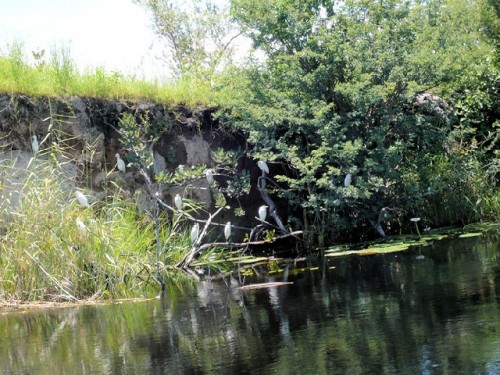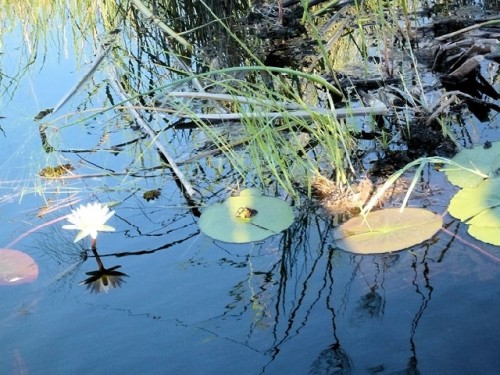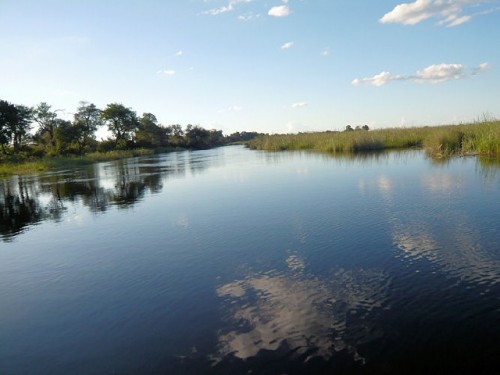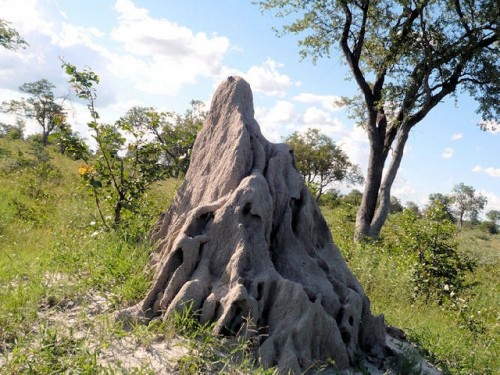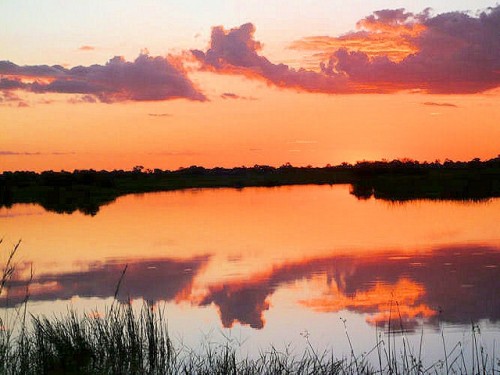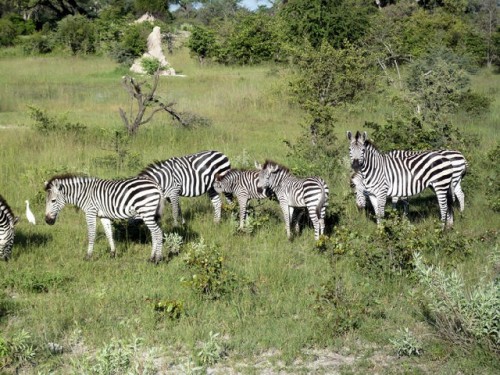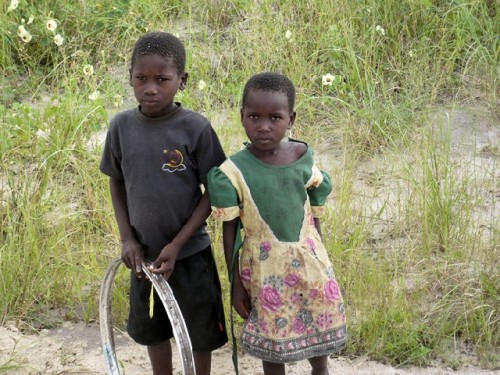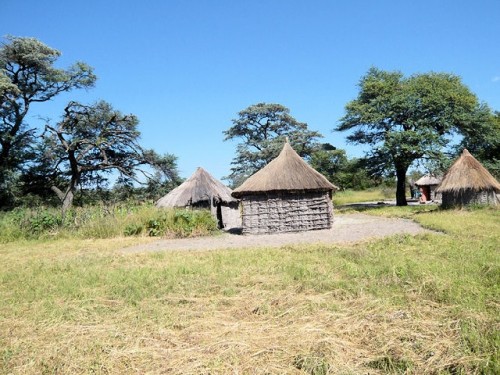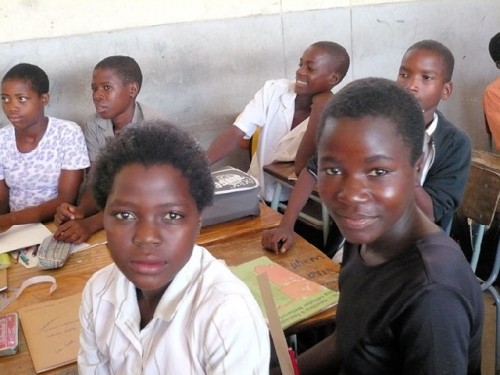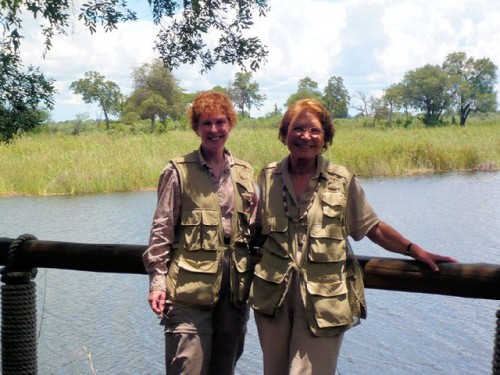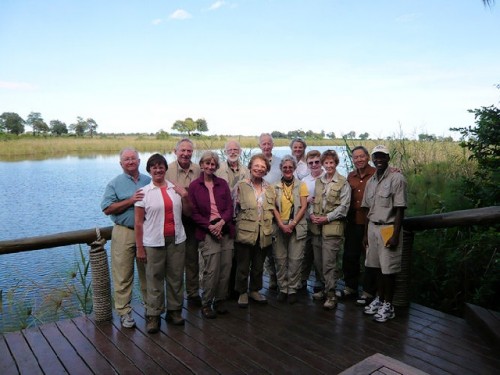Reports on Southern Africa: Part Two
The Caprivi Strip, Namibia
By: Zeren Earls - Mar 24, 2008
A minibus took us to Kasane airport for our flight to Namibia. In a 12-seater aircraft we flew to the Kwando airstrip and walked about ten minutes through sand to get to the boat that delivered us to border control and then to our lodge. The boat ride on the Kwando River (Chobe becomes Kwando in Namibia) was one of the most enjoyable parts of the entire trip. Namibia on the right and Botswana on the left, our pontoon boat moved slowly creating small ripples over the calm waters. Reflections of trees and clouds shimmered on the river's surface as the boat went in and out of lagoons teeming with birds. An avian spectacle included kingfishers in front of their mud holes; weaver birds in nests that looked like thatched roofs perched on trees, bee-eaters, yellow-billed and red-billed hornbills, African Jacana and others in a feeding frenzy along the river's banks.
The boat docked at the Lianshulu Lodge named after the lagoon it overlooks. Our home for the next three nights in Mudumu National Park, Lianshulu is a Lozi (local language) word meaning "the place of spring hares). Over a welcoming drink the manager, an Afrikaner born in Namibia, reviewed rules emphasizing the use of mosquito repellent at all times. It was the rainy season and the mosquitoes were out. As I listened, my eyes wandered over the beautiful local crafts that were displayed in the lodge: baskets, wood carvings and bark paintings. Lunch was waiting: spinach quiche, chicken drumsticks, mixed green salad with balsamic dressing and homemade bread.
The Lianshulu Lodge and cabins are set in the woods. Due to heavy rains, the wilderness tented camp where we were originally going to stay was closed. Needless to say, we were pleased with the upgrade. Not only were our cabins spacious and comfortable, they each had picture windows and a sliding door that opened to a deck surrounded by trees. A giant mosquito net canopied the twin beds.
Following our afternoon quiet time, we had tea and then took off in a pontoon boat for a sunset river cruise. The vegetation along the river provides material for practical goods: Common reeds for fences, bulrush for baskets and papyrus for floor mats and baskets. Three types of water lilies grow in the river: white day lilies, yellow night lilies and blue night lilies, a cross breed of both. The lilies are used in vegetables and in flavoring meats. Their leaves differ in shape; the night lily's has a slit. Sipping our choice of a sundowner drink, we watched a pod of hippos come up for air. Shortly thereafter, reed frogs began their nightly symphony and Landy, our lodge's pet crocodile, rushed home to beat the night. Upon landing, the staff met us with trays of Brown Old Sherry, a South African brand that was superb.
Following a nightly tradition, our chef and a staff member introduced the dinner menu in two different languages: English and a local one to acquaint us with the sounds. The unique dishes excelled in both taste and presentation: sweet potato soup decorated with dribbles of sour cream, ostrich steak and pasta, acorn squash stuffed with cauliflower and carrot, chocolate crepes. I was so amazed at this spread that I had to ask where the local young men received such culinary training. They are all trained by Wilderness Safaris for employment at the concessions.
Early the next morning we had our first game drive in this region known as the Caprivi Strip, an elongated panhandle in the far northeast of Namibia. The flat strip fed by multiple rivers is the wettest region in an otherwise arid country. We drove through woodlands passing by groups of zebras and impalas near water holes. These animals benefit from each other's strengths in detecting danger; zebras have good eyesight and impalas have strong sense of smell. Huge termite mounds popped up randomly like sculptures shaped in clay, some with trees growing out of them. After mating, the male and female termites start a colony, which quickly grows in numbers. Thousands of workers build the mound which gets flooded with heavy rains, drowning the termites. Mounds with escape holes are deserted homes which benefit other wildlife. Birds perching on the mounds drop seeds, thus giving life to new growth.
Adding excitement to our adventure, we got stuck in mud while crossing a big puddle. Our driver was able to get the land rover out of the mud by placing branches under the wheels as he jacked up the vehicle. Meanwhile, Mado entertained us by making music with reeds. He used the sharp edge of one to slice another into different lengths to produce different sounds. This was a skill he had learned as a child growing up in the bush. Boys also made whips or ropes by braiding strong tree barks and ate larva attracted to mopane, also called butterfly tree, because of the shape of its leaves.
The following morning we visited a village and local school. Villages are made up of groups of extended families that live in homesteads. Each homestead is comprised of individual huts that grow in number as boys get married and build their own homes within the compound. Huts are made of mud plastered over branches and water is drawn from a well. Several homesteads form a village, and each village has a headman. A chief is paid by the government to rule over a province made up of villages. Disputes are resolved first by the headman, then the chief, and finally the police. Mobile eye and dental clinics visit villages and schools.
A visit to a historical village introduced us to traditional ways no longer in practice. We watched a woman seated in the center of a semi-circle go into a trance as a shaman danced and drummed around her, building up to frenzy. Blacksmiths used billows to keep a fire going while they shaped scrap metal into spears and hunting tools. In the center of one hut was a tall, circular basket used for grain storage by covering it with grass and sealing it with mud from termite mounds. A trap weighted down by mud patties was set outside the hut to protect the grain from mice. Using a bare branch as a ladder, chickens climbed into the central coop at night, while a nearby trap for wild cats kept them safe.
Our visit to a local school in a village of 300 people provided further insight. The school had 354 students, who walked through the bush to get there. Classes were mixed for boys and girls and accommodated approximately 35 students each. We visited the 4th and 8th grades; each classroom had students of varying ages and sizes. They were all learning English and welcomed us to look at their notebooks. Having no access to computers, they had mastered beautiful hand writing in script. During recess we met a Peace Corps volunteer on a two year assignment to teach science. She mentioned that nutrition was lacking in the students' daily diet which is based mostly on maize and sorghum. She also said that 50% of the village population is HIV positive, with a funeral nearly every day. The people die mostly of aids or malaria. She herself had contracted malaria a few months after her arrival and had had to travel 12 hours to get treatment. She plans to go to medical school after Peace Corps and return to Africa one day to practice medicine. Her idealism is commendable.
We had two informative lectures on Namibia: One on the history and economy, the other on the Caprivi Strip. Early inhabitants of Namibia were nomadic Bushmen, who followed animals for sustenance. Eventually, they were chased into the desert by incoming tribes from other areas. Europeans did not enter Namibia until the middle of the 19th century because the Namibian desert runs along the Atlantic coast for 850 miles, acting as a shield against potential invaders. In fact, the name Namibia means "shield". So Namibia remained tribal land until missionaries arrived in 1840 and the Germans in 1880 looking for ivory. It was taken over by Germany in 1890 and called Southwest Africa. Tribes were split as borders with neighboring Botswana to the east, Angola and Zambia to the north and South Africa to the south were established. In 1914 the British took Southwest Africa from Germany and annexed it to colonial South Africa. Inspired by the liberation struggles in South Africa, the people in Southwest Africa organized and fought for independence. They renamed the country Namibia and held national elections in 1989.
The Namibian flag has five diagonal stripes: yellow for sun, blue for water, green for vegetation, red for dignity and white for peace. Namibia's economy is driven by mining, fishing, tourism and agriculture. Diamonds were discovered in 1908 during the construction of the Dutch railway. A diamond's value is determined by the four Cs: cut, color, clarity and carat weight. Also mined are copper and uranium. Tourism is the biggest and fastest growing industry. Fishing is concentrated along the Atlantic coast.
The Caprivi Strip is being developed for tourism. This narrow panhandle originally belonged to Britain. German Chancellor Leopold von Caprivi, in a bid to gain access to the Zambezi River, negotiated with the British for the strip, which was then given his name. After World War 1, it was returned to the British, it finally became part of independent Namibia in 1989. Twelve thousand people from eight different tribes had lived all over this region. They were relocated, however, in order to create Mudumu National Park, an important initiative to preserve wildlife and encourage tourism.
During a final pontoon boat cruise our guide treated us to garlands and necklaces he made from water lilies. We spotted eagles on trees, hippos in dusk and treasured yet another spectacular sunset. The chef outdid himself for our goodbye dinner: Pot au feu with eggplant, carrots, onions and cloves, polenta, baked sliced squash with thyme, and for dessert yogurt mousse with apricot sauce. The talented staff danced and drummed for us. Afterwards over a cup of tea of our choice, including bush tea made from russet bush willow, we gazed at stars in the expansive midnight blue overhead, thus ending our memorable trip to Namibia.

